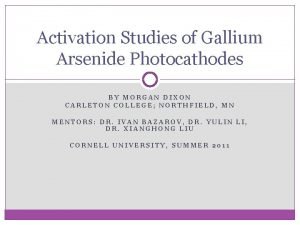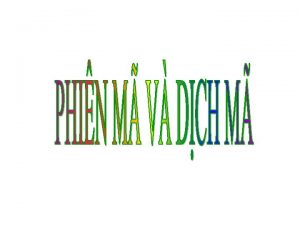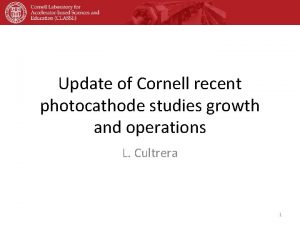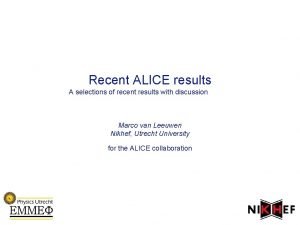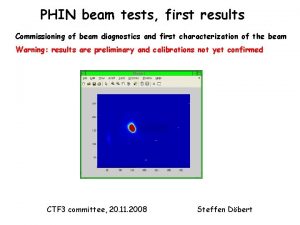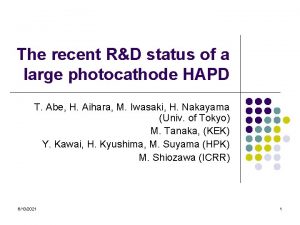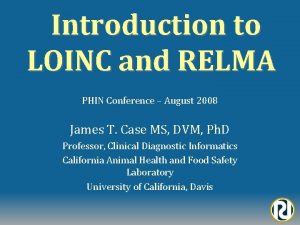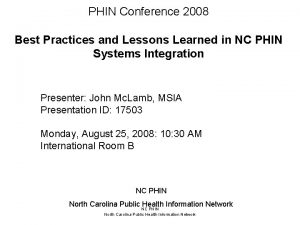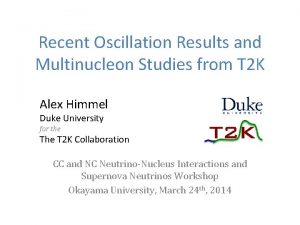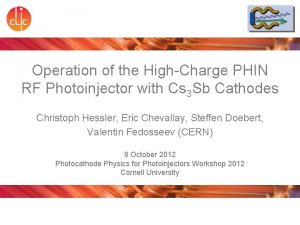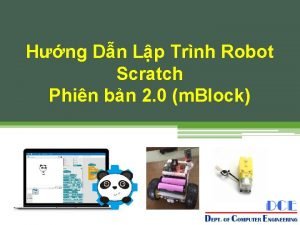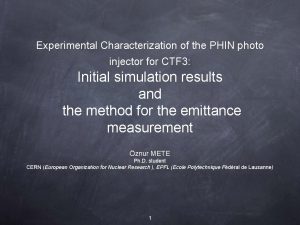Recent Results from the PHIN and Photocathode Studies




















- Slides: 20

Recent Results from the PHIN and Photocathode Studies Christoph Hessler, Irene Martini, Eric Chevallay, Steffen Doebert, Valentin Fedosseev, Florence Friebel, Piotr Gach, Mikhail Martyanov CLIC Workshop 2016, CERN 19. 01. 2016

PHIN Layout VW 19. 01. 2016 FCT: Fast current transformer VM: Vacuum mirror SM: Steering magnet BPM: Beam position monitor MSM: Multi-slit Mask OTR: Optical transition radiation screen MTV: Gated cameras SD: Segmented dump FC: Faraday cup VW: Vacuum window C. Hessler, I. Martini, E. Chevallay, S. Doebert, V. Fedosseev, F. Friebel, P. Gach, M. Martyanov 2

Vacuum Improvement at PHIN March 2011 Dynamic vacuum level: 4 e-9 mbar Static vacuum level: 2. 2 e-10 mbar 19. 01. 2016 March 2012 Activation of NEG chamber around gun 7 e-10 mbar 1. 3 e-10 mbar July 2013 Installation of additional NEG pump 2 e-10 mbar 2. 4 e-11 mbar C. Hessler, I. Martini, E. Chevallay, S. Doebert, V. Fedosseev, F. Friebel, P. Gach, M. Martyanov 3

Impact of Vacuum on Cs 2 Te Cathode Lifetime Comparison of Cs 2 Te photocathode lifetime measurements with same beam properties but different vacuum conditions: 2014 l=262 nm t 2 = 300 h 2. 3 n. C, 350 ns, Cs 2 Te #198 Cathode #185 Dynamic pressure: 3 e-10 mbar Substantial improvement of dynamic vacuum level has resulted in drastic increase of 1/e lifetime from 38 to 300 h. C. Hessler et al. , “Lifetime Studies of Cs 2 Te Cathodes at the PHIN RF Photoinjector at CERN”, Proc. of IPAC’ 12, New Orleans (2012), p. 1554. 19. 01. 2016 C. Hessler, I. Martini, E. Chevallay, S. Doebert, V. Fedosseev, F. Friebel, P. Gach, M. Martyanov 4

Vacuum Issues during Long Train Operation § Strong pressure increase due to Faraday cup heating was sometimes observed in the past, when operating PHIN with 1. 2 µs train length. § Aim to increase train length further to approach CLIC requirements. § Beam power for 5 µs trains with 5 Hz rep rate and 2. 3 n. C/bunch: 430 W → too much for uncooled FC! § Installation of vacuum exit window and operation of FC in air in 2013. → Ringing on FC signal / other issues. § Creation of a new vacuum sector separated from beam line by vacuum window in 2015. 19. 01. 2016 Cathode #189 (PHIN run 2012) Pressure increase to 2 e-7 mbar VW New vacuum sector C. Hessler, I. Martini, E. Chevallay, S. Doebert, V. Fedosseev, F. Friebel, P. Gach, M. Martyanov 5

Long Train Operation beyond PHIN Specs § § Operation with 1. 6 µs (beyond PHIN specs), 2. 3 n. C/bunch and 0. 8 Hz rep rate. Faraday cup has been separated from the rest of the beam line by a vacuum window. T L U 2015 N I M I L E R P Y R A S E R 2. 3 n. C, 1. 6 µs, 0. 8 Hz, Cs 2 Te #203 19. 01. 2016 § § Vacuum at the exit of the gun stayed at low e-10 mbar level, whereas the vacuum in the new Faraday cup sector increased up to 4 e-6 mbar. No real decrease of the QE visible! Oscillations on the measured QE curve are due to problems with the temperature stability in the laser lab. The phase was slowly drifting, probably also due to the problems with the temperature stability. C. Hessler, I. Martini, E. Chevallay, S. Doebert, V. Fedosseev, F. Friebel, P. Gach, M. Martyanov 6

5 Hz Operation with Cs 2 Te Cathode § Operation with 1. 6 µs (beyond PHIN specs), 2. 0 n. C/bunch and 5 Hz rep rate. T L U 2015 Y R A S E R N I M PR § § § I L E 2. 0 n. C, 1. 6 µs, 5 Hz, Cs 2 Te #203 QE seemed initially to decrease, but could be restored by changing the phase. → Evident that phase is drifting. Also in this measurement, QE seems to be constant. Pressure was higher than during 0. 8 Hz measurement: ~6 e-10 mbar at the exit of the gun. 19. 01. 2016 C. Hessler, I. Martini, E. Chevallay, S. Doebert, V. Fedosseev, F. Friebel, P. Gach, M. Martyanov 7

Interpretation of Results § Despite that the vacuum level was similar or slightly worse (5 Hz measurement) than during 2014, the cathode lifetime was significantly better. § Possible explanations: § Outgassing of Faraday cup produces some residual gas species, which are detrimental for the photocathode. § Or it was just a very good photocathode… But why should this photocathode be so much better than the previous ones? § To verify this … § Further lifetime measurements (more statistics) are needed § Detailed investigation of the residual gas composition is needed § Studies of photocathode performance in PHIN with deliberately introduced residual gas species would be helpful. § Better understanding of chemical composition of photocathode surface and of preparation process needed. 19. 01. 2016 C. Hessler, I. Martini, E. Chevallay, S. Doebert, V. Fedosseev, F. Friebel, P. Gach, M. Martyanov 8

XPS Surface Analysis Studies of Photocathodes § § Surface analysis of photocathode materials with XPS and their impact on the cathode performance in collaboration with TE/VSC. New UHV carrier vessel (designed by and built in collaboration with LAL) allows to transfer cathodes under vacuum from production laboratory to the XPS setup. XPS measurement allows material characterization of the surface. Together with qualitative elemental composition also chemical and quantitative information can be obtained (not straightforward). In this study a correlation between the chemical composition of the surface and the QE has been found. The poor photoemissive properties (of used cathodes) are accompanied by surface contamination and not good stoichiometry of the cathodes composition. I. Martini et al. , “X-ray Photoemission Spectroscopy Studies of Cesium Antimonide Photocathodes for Photoinjector Applications”, Phys. Proc. 77 (2015) 34 - 41. 19. 01. 2016 Transfer vessel Courtesy I. Martini C. Hessler, I. Martini, E. Chevallay, S. Doebert, V. Fedosseev, F. Friebel, P. Gach, M. Martyanov 9

XPS Analysis of Cs 2 Te Cathode #203 § Cs 2 Te cathode #203 after production: § § No oxygen or oxide contamination visible. Good stoichiometry n(Cs)/n(Te)=~2 Copper from substrate visible After operation in PHIN: § § Te. O 3 and metallic Te were formed during degradation process Larger quantity of Cu visible, probably coating has been partially removed by ion bombardment. I. Martini, “Characterization of Cs-Sb cathodes for high charge RF photoinjectors”, PHD Thesis, Politecnico di Milano, 2016 19. 01. 2016 Courtesy I. Martini C. Hessler, I. Martini, E. Chevallay, S. Doebert, V. Fedosseev, F. Friebel, P. Gach, M. Martyanov 10

XPS Analysis of Cs 3 Sb Cathodes #199 § Cs 3 Sb cathode #199 after operation in PHIN RF gun: § § § 19. 01. 2016 Oxygen is the only contaminant. 4 different states of Sb: Cs 3 Sb, alkali-deficient component, metallic Sb, Sb 2 O 3 O 1 s level → Cs 3 O 11 , Sb 2 O 3 Strong QE degradation is related to the oxidation. Sb-rich phase could either be created during production (no XPS measurement of this cathode before usage in PHIN available) or due to high energy ions impinging the cathode surface. fresh used Courtesy I. Martini, “Characterization of Cs-Sb cathodes for high charge RF photoinjectors”, PHD Thesis, Politecnico di Milano, 2016 C. Hessler, I. Martini, E. Chevallay, S. Doebert, V. Fedosseev, F. Friebel, P. Gach, M. Martyanov 11

XPS Analysis of Cs 3 Sb Cathodes #202 § Cs 3 Sb cathode #202 after production: § § Sb-rich phase O 1 s peaks could be explained by Cs 3 O 11 and H 2 O fresh § used After operation in DC gun: § § § Sb-rich peak has increased Oxygen and carbon contamination is present and can be explained by CO 32 -: Cs has probably reacted with CO 2 to Cs 2 CO 3 Cs 3 O 11 or H 2 O not excluded I. Martini, “Characterization of Cs-Sb cathodes for high charge RF photoinjectors”, PHD Thesis, Politecnico di Milano, 2016 19. 01. 2016 Courtesy I. Martini C. Hessler, I. Martini, E. Chevallay, S. Doebert, V. Fedosseev, F. Friebel, P. Gach, M. Martyanov 12

XPS Analysis of Copper Substrate § QE of copper substrate 6 A 46 has been measured in PHIN for AWAKE: QE = 2. 6 e-4, which is too high for Cu. § This plug was not baked in the preparation chamber, therefore it was assumed to be clean. § However, XPS measurement confirmed small Cs contamination: Figure courtesy I. Martini § Explanation: Contamination occurred probably during short-time storage in (cold) RF oven in preparation chamber, which cannot be avoided. 19. 01. 2016 C. Hessler, I. Martini, E. Chevallay, S. Doebert, V. Fedosseev, F. Friebel, P. Gach, M. Martyanov 13

Summary of XPS Studies § XPS is a very useful tool for studying the surface composition of photocathodes. § Already interesting differences of Cs 3 Sb cathodes operated in the DC and RF gun were found. § More statistics needed for a better understanding of the production and deterioration processes § A UHV transport vessel is currently being constructed by ASTe. C, Daresbury. This device will allow that photoemissive coatings produced at CERN can be used and studied at Daresbury, which will enable the possibility to investigate the morphology and local elemental composition of the coatings using AFM (Atomic Force Microscopy) and SEM (Scanning Electron Microscopy). 19. 01. 2016 C. Hessler, I. Martini, E. Chevallay, S. Doebert, V. Fedosseev, F. Friebel, P. Gach, M. Martyanov 14

New Evaporator Setups § New evaporator setups for increasing the capacity of Cs dispensers and reducing frequency for changing them (Te/Sb evaporators have a higher capacity): Double SAES dispenser setup: § Double Alvatec dispenser setup: New 3 component setup for production of bi-alkali photocathodes like K 2 Cs. Sb: 3 component Setup: § Most parts ready to be installed. 19. 01. 2016 Figure courtesy P. Gach C. Hessler, I. Martini, E. Chevallay, S. Doebert, V. Fedosseev, F. Friebel, P. Gach, M. Martyanov 15

Outlook Photocathode R&D: § Continue studies on new cathode materials sensitive to visible light: Multi-alkali photocathodes like e. g. K 2 Cs. Sb, Na 2 KSb, … § Continue surface analysis studies of photocathodes. PHIN studies which would be interesting (not all possible): § § § § Perform long train measurement with Cs 3 Sb and again with Cs 2 Te cathodes. Study of impact of residual gas species on photocathode performance. Push parameters as far as possible towards CLIC requirements (5 µs trains @ 5 Hz) Study of impact of the longer bunch spacing with new laser front end on the photocathode lifetime. Study of charge stability with the new laser system. Study the effect of surface roughness on cathode lifetime (Electro-polished substrates). Study the performance of three components cathodes in PHIN (e. g. K 2 Cs. Sb). Studies for AWAKE Beyond PHIN: § PHIN will be used for AWAKE experiment → No real possibility to continue then CLIC drive beam photoinjector studies at PHIN. § Given the new results and the problems with thermionic gun last summer it is still important to continue photoinjector studies for CLIC in some way. 19. 01. 2016 C. Hessler, I. Martini, E. Chevallay, S. Doebert, V. Fedosseev, F. Friebel, P. Gach, M. Martyanov 16

Acknowledgement § Controls: Mark Butcher, Mathieu Donze, Alessandro Masi, Christophe Mitifiot § BI: Thibaut Lefevre, Stephane Burger, Stefano Mazzoni § Vacuum: Herve Rambeau, Andrew Bruton § RF: Stephane Curt, Stephane Rey, Heiko Damerau § Wilfrid Farabolini § CTF 3 operators § XPS studies: Holger Neupert, Valentin Nistor, Mauro Taborelli, Elise Usureau § Collaborators at ASTe. C, LAL and IAP-RAS § … and many others … and thank you for your attention! 19. 01. 2016 C. Hessler, I. Martini, E. Chevallay, S. Doebert, V. Fedosseev, F. Friebel, P. Gach, M. Martyanov 17

Backup Slides 19. 01. 2016 C. Hessler, I. Martini, E. Chevallay, S. Doebert, V. Fedosseev, F. Friebel, P. Gach, M. Martyanov 18

Challenge to Verify Feasibility of Drive-Beam Photoinjector § CLIC requirements far beyond PHIN specs: Different macro-pulse repetition rates: 0. 8 – 5 Hz (PHIN) 50 Hz (CLIC) § § One PHIN run per year with 3 cathodes to test. → No statistics possible under these conditions! Photocathode lifetime measurements require long measurement periods, which are in general not available to the extend as needed. 19. 01. 2016 C. Hessler, I. Martini, E. Chevallay, S. Doebert, V. Fedosseev, F. Friebel, P. Gach, M. Martyanov 19

PHIN and CLIC Parameters Main beam Drive beam Parameter CALIFES (CTF 3) PHIN (CTF 3) CLIC requirem. Charge per bunch (n. C) 0. 6 2. 3 (9. 2) 8. 4 Macro pulse length (μs) <0. 2 1. 2 (1. 6) 140 Bunch spacing (ns) 0. 66 2. 0 Gun RF / bunch rep. rate (GHz) 3 / 1. 5 1 / 0. 5 Number of bunches in macro pulse 1 – 300 1800 (2400) 70000 Macro pulse rep. rate (Hz) 5 5 (5) 50 Charge per macro pulse (μC) <0. 18 4. 1 (5. 5) 590 Beam current in macro pulse (A) 0. 9 3. 5 4. 2 Bunch length (ps) 10 10 10 Charge stability <3% <0. 25% (<1%) <0. 1% Cathode lifetime (Cs 2 Te) 1 y (QE>0. 3%) >50 h (QE>3%) (>300 h) >150 h (QE>3%) Cathode type Cs 2 Te (in-situ, dual layer) Cs 2 Te, Cs 3 Sb (co-deposition) To be defined Norm. emittance (μm) <20 <25 (14) <100 19. 01. 2016 C. Hessler, I. Martini, E. Chevallay, S. Doebert, V. Fedosseev, F. Friebel, P. Gach, M. Martyanov 20
 Gaas photocathode
Gaas photocathode A friend emails you the results of a recent high school
A friend emails you the results of a recent high school Paradigm shift from women studies to gender studies
Paradigm shift from women studies to gender studies Recent trends in ic engine
Recent trends in ic engine Recent developments in ict
Recent developments in ict Recent developments in object detection
Recent developments in object detection Ap synthesis prompt
Ap synthesis prompt Recent trends in foreign trade
Recent trends in foreign trade In recent years evidence has been collected
In recent years evidence has been collected Modern trends in project management
Modern trends in project management Recent demographic changes in the uk
Recent demographic changes in the uk Schoology myips
Schoology myips Biotaphonomy
Biotaphonomy After kato's serious motorcycle accident
After kato's serious motorcycle accident Recent advances in ceramics
Recent advances in ceramics News report passive voice
News report passive voice Https drive google com
Https drive google com Can backdated udin be generated
Can backdated udin be generated Emerging trends in mis
Emerging trends in mis Comait
Comait Hát kết hợp bộ gõ cơ thể
Hát kết hợp bộ gõ cơ thể
